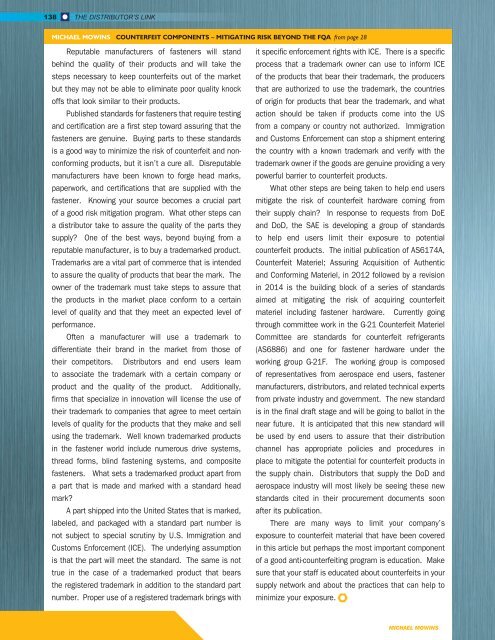FALL 2016
Distributor's Link Magazine Fall Issue 2016 / Vol 39 No4
Distributor's Link Magazine Fall Issue 2016 / Vol 39 No4
You also want an ePaper? Increase the reach of your titles
YUMPU automatically turns print PDFs into web optimized ePapers that Google loves.
138<br />
THE DISTRIBUTOR’S LINK<br />
MICHAEL MOWINS COUNTERFEIT COMPONENTS – MITIGATING RISK BEYOND THE FQA from page 28<br />
Reputable manufacturers of fasteners will stand<br />
behind the quality of their products and will take the<br />
steps necessary to keep counterfeits out of the market<br />
but they may not be able to eliminate poor quality knock<br />
offs that look similar to their products.<br />
Published standards for fasteners that require testing<br />
and certification are a first step toward assuring that the<br />
fasteners are genuine. Buying parts to these standards<br />
is a good way to minimize the risk of counterfeit and nonconforming<br />
products, but it isn’t a cure all. Disreputable<br />
manufacturers have been known to forge head marks,<br />
paperwork, and certifications that are supplied with the<br />
fastener. Knowing your source becomes a crucial part<br />
of a good risk mitigation program. What other steps can<br />
a distributor take to assure the quality of the parts they<br />
supply? One of the best ways, beyond buying from a<br />
reputable manufacturer, is to buy a trademarked product.<br />
Trademarks are a vital part of commerce that is intended<br />
to assure the quality of products that bear the mark. The<br />
owner of the trademark must take steps to assure that<br />
the products in the market place conform to a certain<br />
level of quality and that they meet an expected level of<br />
performance.<br />
Often a manufacturer will use a trademark to<br />
differentiate their brand in the market from those of<br />
their competitors. Distributors and end users learn<br />
to associate the trademark with a certain company or<br />
product and the quality of the product. Additionally,<br />
firms that specialize in innovation will license the use of<br />
their trademark to companies that agree to meet certain<br />
levels of quality for the products that they make and sell<br />
using the trademark. Well known trademarked products<br />
in the fastener world include numerous drive systems,<br />
thread forms, blind fastening systems, and composite<br />
fasteners. What sets a trademarked product apart from<br />
a part that is made and marked with a standard head<br />
mark?<br />
A part shipped into the United States that is marked,<br />
labeled, and packaged with a standard part number is<br />
not subject to special scrutiny by U.S. Immigration and<br />
Customs Enforcement (ICE). The underlying assumption<br />
is that the part will meet the standard. The same is not<br />
true in the case of a trademarked product that bears<br />
the registered trademark in addition to the standard part<br />
number. Proper use of a registered trademark brings with<br />
it specific enforcement rights with ICE. There is a specific<br />
process that a trademark owner can use to inform ICE<br />
of the products that bear their trademark, the producers<br />
that are authorized to use the trademark, the countries<br />
of origin for products that bear the trademark, and what<br />
action should be taken if products come into the US<br />
from a company or country not authorized. Immigration<br />
and Customs Enforcement can stop a shipment entering<br />
the country with a known trademark and verify with the<br />
trademark owner if the goods are genuine providing a very<br />
powerful barrier to counterfeit products.<br />
What other steps are being taken to help end users<br />
mitigate the risk of counterfeit hardware coming from<br />
their supply chain? In response to requests from DoE<br />
and DoD, the SAE is developing a group of standards<br />
to help end users limit their exposure to potential<br />
counterfeit products. The initial publication of AS6174A,<br />
Counterfeit Materiel; Assuring Acquisition of Authentic<br />
and Conforming Materiel, in 2012 followed by a revision<br />
in 2014 is the building block of a series of standards<br />
aimed at mitigating the risk of acquiring counterfeit<br />
materiel including fastener hardware. Currently going<br />
through committee work in the G-21 Counterfeit Materiel<br />
Committee are standards for counterfeit refrigerants<br />
(AS6886) and one for fastener hardware under the<br />
working group G-21F. The working group is composed<br />
of representatives from aerospace end users, fastener<br />
manufacturers, distributors, and related technical experts<br />
from private industry and government. The new standard<br />
is in the final draft stage and will be going to ballot in the<br />
near future. It is anticipated that this new standard will<br />
be used by end users to assure that their distribution<br />
channel has appropriate policies and procedures in<br />
place to mitigate the potential for counterfeit products in<br />
the supply chain. Distributors that supply the DoD and<br />
aerospace industry will most likely be seeing these new<br />
standards cited in their procurement documents soon<br />
after its publication.<br />
There are many ways to limit your company’s<br />
exposure to counterfeit material that have been covered<br />
in this article but perhaps the most important component<br />
of a good anti-counterfeiting program is education. Make<br />
sure that your staff is educated about counterfeits in your<br />
supply network and about the practices that can help to<br />
minimize your exposure.<br />
MICHAEL MOWINS

















